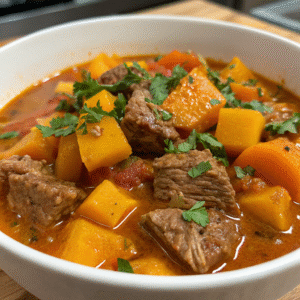
Beef and Butternut Squash Stew
A hearty, flavorful Beef and Butternut Squash Stew featuring tender beef and sweet squash in a rich, savory broth.
Ingredients
Main Ingredients
- 2 tbsp olive oil
- 2 lbs beef chuck, cut into 1-inch cubes
- 1/4 cup all-purpose flour
- 1 tsp salt
- 1/2 tsp black pepper
- 1 large yellow onion, chopped
- 2 large carrots, peeled and sliced
- 2 celery stalks, sliced
- 4 cloves garlic, minced
- 1/2 cup dry red wine optional, can substitute with more beef broth
- 4 cups beef broth
- 2 tbsp tomato paste
- 1 tbsp Worcestershire sauce
- 1 tsp dried thyme
- 1 bay leaf
- 1 medium butternut squash, peeled, seeded, and cut into 1-inch cubes about 3 lbs
- 2 tbsp fresh parsley, chopped, for garnish
Instructions
- Prepare the Beef: In a large bowl, combine the flour, salt, and pepper. Add the beef cubes and toss to coat evenly. This not only seasons the meat but also helps create a flavorful crust and acts as a thickening agent for the stew.
- Sear the Beef: Heat the olive oil in a large Dutch oven or heavy-bottomed pot over medium-high heat. Working in batches to avoid overcrowding the pan, add the floured beef and sear on all sides until well-browned. Transfer the seared beef to a separate plate and set aside.
- Sauté the Aromatics: Reduce the heat to medium. Add the chopped onion, carrots, and celery to the same pot. Sauté for 5-7 minutes, or until the vegetables have softened. Add the minced garlic and cook for another minute until fragrant.
- Deglaze and Build the Broth: If using, pour in the red wine to deglaze the pot, scraping up any browned bits from the bottom with a wooden spoon. Let it simmer for 2 minutes to cook off the alcohol. Whisk in the tomato paste, then pour in the beef broth and Worcestershire sauce. Add the thyme and bay leaf.
- Simmer the Stew: Return the seared beef to the pot. Bring the liquid to a simmer, then reduce the heat to low, cover, and let it cook for at least 1.5 to 2 hours, or until the beef is becoming tender. The low and slow cooking process is key to breaking down the connective tissues in the beef.
- Add Butternut Squash: Add the cubed butternut squash to the pot. Stir gently, cover, and continue to simmer for another 30-45 minutes, or until both the beef and squash are fork-tender. Adding the squash later prevents it from becoming mushy.
- Final Touches and Serving: Remove the bay leaf. Taste the stew and adjust seasoning with additional salt and pepper if needed. If the stew is not as thick as you'd like, you can simmer it uncovered for a few minutes. Garnish with fresh parsley before serving hot.
Notes
- Don't Skip the Sear: Browning the beef is the most important step for developing a deep, complex flavor.
- Low and Slow is Key: Don't try to rush the cooking process by boiling the stew. A gentle simmer is essential for tenderizing the tough cut of beef.
- Let It Rest: Like many stews, this one tastes even better the next day. If you have time, make it a day ahead to allow the flavors to meld completely.
- Fresh Garnish: A sprinkle of fresh parsley or thyme just before serving brightens up the rich flavors of the stew.